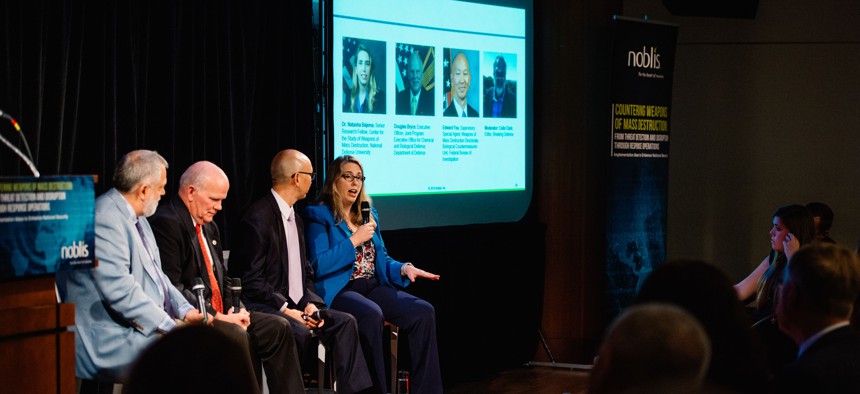5 Key Takeaways from a Discussion on CWMD, hosted by Noblis
Presented by
Noblis

Decision makers in homeland security, defense, and intelligence are faced with adversaries of increasing sophistication. These adversaries — including rogue states, threat actors, and terrorists — have access to deadly chemical, biological, radiological, nuclear and explosive (CBRNE) weapons that must be detected, deterred, attributed, and responded to with agility.
Now more than ever, countermeasures must be a mission priority across government, defense, and industry. It is imperative for the U.S. to stay multiple steps ahead of threat through innovation, collaboration, and the deployment of state-of-the-art technology.
That’s why on September 13, 2018, Noblis, a nonprofit science, technology, and strategy organization, was honored to host a premier event in downtown Washington, D.C. with federal, defense, and industry leaders. We explored ideas and concerns on the future of national security and countering CBRNE threats.
If you missed the event, read below for a recap of the morning talks.
1. Security requires continued integration
A priority concern for speakers was the growing need for a unified, formalized, and integrated cross-agency framework for dealing with CBRNE threats. The conversation suggested a solution that would span the Department of Defense (DoD), the Department of Homeland Security (DHS), the FBI, ICE, TSA, as well as the full range of state and local authorities and first responders.
DHS made significant strides toward just such an integration at the end of 2017 when Secretary Nielsen established the Countering Weapons of Mass Destruction Office (CWMDO). James McDonnell, Assistant Secretary of the CWMDO, served as the event’s keynote speaker. He noted that by forming the new office, the funding available to DNDO was linked to the sustainable product pipeline and a trained cadre of biochemical and toxicology experts from the OHA, solving a crucial problem for DHS.
The issue of integration was a recurring theme throughout the event. Several speakers highlighted the urgent need for more open communications, cooperation and integration across federal, state and local offices, as well as with the military and academia.
Amanda Richardson, Chief of Research and Development Operations, Research and Development Directorate, Defense Threat Reduction Agency (DTRA), noted that “the challenge is building [collaboration] into a lasting infrastructure based not just on personal relationships, but organizational one that is longer-lasting and more robust.”
2. Data, data, data
Leading U.S. commercial institutions have spent the last two decades shifting their entire scope of operations to an increasingly digital environment. Therefore, it comes as no surprise that CBRNE security experts have a priority focus on big data, bioinformatics and high-speed computing, all of which are crucial for developing robust defenses against lethal biological pathogens and deadly chemical agents.
Richardson noted that “when it comes to information sharing, it’s not just about knowing the people, it’s knowing whether your data work can work with my system [and vice versa].”
Dr. Natasha Bajema, Senior Research Fellow, Center for the Study of Weapons of Mass Destruction, National Defense University, emphasized the cost of losing the digital race. “We’re definitely missing the digital components. Our adversaries are not going to look at the boxes we’re covering [in capabilities, resources and expertise]. If we’re not watching the digital space, they’re going to leverage the digital space against us.”
Dr. Huban Gowadia, former Director of the DHS Domestic Nuclear Detection Office, cited the positive aspects of the wealth of such data, and pointed out that shared data and data analytics constitutes “the glue between agencies,” and should provide the greater cohesion across agencies that all the speakers emphasized.
3. Biological threats constitute a serious and growing concern
The security architecture that is gradually absorbing all CBRNE concerns was originally founded to deal with nuclear threats. Today, however, the most vexing and problematic danger is identifying biological threats.
The event included a research presentation by Dr. Sterling Thomas of Noblis, who shed insight on the threat of bioweapons, and how emerging technology has expanded to combat those threats.
One national security concern that Dr. Thomas shared is that biological pathogens will present additional challenges one day if they are ever engineered to propagate more easily. “The Ebola virus can’t live in the air,” Dr. Thomas noted, “But, what happens if Ebola could [be engineered] to live in the air? One of the challenges of dealing with pathogens is having to work out how fast we can figure them out.”
There is, however, a silver lining that holds promise. Gene sequencing and manipulation work both ways. It is just as possible to neutralize a pathogen through powerful genetic manipulation as it is to weaponize one. With more PCR markers and better access to data across government and defense, biological counterterrorism is becoming increasingly advanced as labs, academic institutions, and federal agencies have begun to invest more in these areas.
4. The end user is the crucial user
The speakers uniformly emphasized the need to tailor programs to the specific needs of security and military personnel on the ground. All too frequently, front-line operators simply have no access to the best solutions or technology. McDonnell called this the “technology valley of death,” where an expensive, time-consuming, poorly-planned product ends up unused or unusable.
“The tension between the operator wanting something yesterday,” Gowadia said, “and the scientist wanting to give you something in 10 years, is palpable.”
Colonel Thamar Main, Principal Director of DoD’s Chemical and Biological Defense Program, urged federal agencies to resist setting threshold requirements for solutions based on industry standards. “Your requirement should be tracked backward from what you’re really trying to accomplish in terms of equipment capabilities and their utility to the mission,” Colonel Main said.
Douglas Bryce, Executive Director, Joint Program Executive Office for Chemical and Biological Defense, DoD, noted that “all the data in the world is useless if the [impact] is inaccessible to a soldier in the field.” Panelists agreed that processing data in the field is a serious, urgent and life-threatening need.
5. The new space race
It’s clear that WMDs are now easier to produce and far more devastating than in years past. Ed You, of the FBI’s WMD Directorate, urged audience members to consider how the U.S. is protecting the agriculture, additive manufacturing, health, alternative and renewable energy sources as bioweapons sophisticate.
“We are in the midst of a biological space race, and America’s Sputnik moment has yet to come,” remarked You.
Jumping off the “space race” comparison, Bryce emphasized the long-term nature of this mission.
“We need a multi-year plan where we can clearly see where to plug in science and technology. That’s how we’re going to make the next generation move,” he said. “This problem doesn’t go away, it just gets bigger, so we need to find different ways to attack the problem.”
For more information on Noblis’ CWMD18 event, visit here.
To contact Noblis about bioinformatics tools and research, click here.
This content is made possible by Noblis. The editorial staff of Government Executive was not involved in its preparation.







